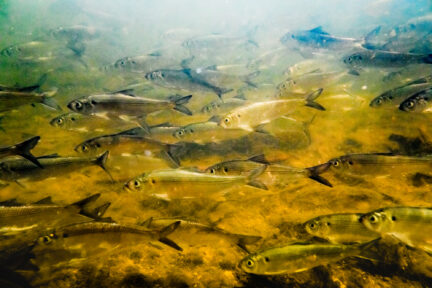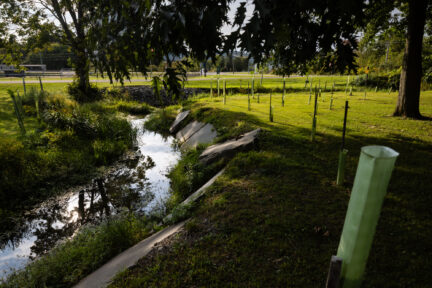Bay Shows Signs of Resilience as Partners Report on Health and Progress
Bay Shows Signs of Resilience as Partners Report on Health and Progress
The Chesapeake Bay Program’s analysis of recent data on the health of the Chesapeake Bay and its watershed shows an ecosystem that is resilient, even as it remains impaired and population continues to increase. The Bay Program’s Bay Barometer: Spotlight on Health and Restoration of Chesapeake Bay and Watershed, which was released today at the Virginia Living Museum, offers a science-based snapshot of current watershed-wide progress toward a healthy Bay ecosystem.
Though health indicators continue to reflect the reality of an impaired Bay and local waterways, significant restoration actions and pollution reductions give Bay officials cause for optimism.
Chesapeake Bay Program Director Nick DiPasquale said, “While we clearly have a lot of work to do, the Bay is resilient and we have reason for hope. We know this complex ecosystem will respond to restoration efforts and we expect to see encouraging news for 2012 data. This includes news such as the increase in juvenile crabs, early reports of perhaps the smallest ‘dead zone’ in over 25 years and restoration accomplishments that will result in more positive health indicators in years to come.”
DiPasquale also noted that partners – the six Bay states, the District of Columbia, the Chesapeake Bay Commission and the Environmental Protection Agency – are making significant progress toward improved water quality by putting their local pollution-reducing plans into action. In just two years, Bay Program partners estimate that they moved 20 percent closer to their goal for reducing nitrogen, 19 percent closer for phosphorus and 30 percent closer for sediment.
“The strides the Bay partners are making to meet our water quality goals under the Bay pollution diet show we’re taking the Bay restoration effort seriously and our reporting systems are getting better and better, improving our own accountability,” said DiPasquale.
The following are some highlights of this year’s Bay Barometer:
Indicators of an Impaired Chesapeake Bay
- Only 34 percent of the Bay met dissolved oxygen standards
- Water clarity was very poor
- Oyster populations remain low—less than 1 percent of historic levels
- A majority of freshwater streams are in poor or very poor condition
Signs of Resilience and Hope
- Not only did the large Susquehanna Flats grass bed survive Tropical Storm Lee in 2011, but grasses in the mid-Bay witnessed dramatic increases
- The Bay’s rockfish population, once threatened, remains stable and above target
- The adult female crab population, though down, is still within sustainable range, and early news of the highest number of juveniles since 1993 gives us hope for good figures on 2012 and in 2013
- Early indications are that the 2012 dead zone was the smallest since 1985
Major Restoration Accomplishments
- Increased 240 miles of forested buffers, largely planted by rural landowners
- 148 more miles of streams were opened for use by migratory fish to reach necessary spawning grounds
- 15 new public access sites opened, giving people access to the water
- More than 8 million acres of land have been preserved since 2000
Progress toward Meeting the Bay Total Maximum Daily Load (TMDL) – a.k.a. the “pollution diet”
Estimates indicate that between July 2009 and June 2011, as a result of pollution-reducing practices implemented:
- Nitrogen loads to the Bay decreased by 15.67 million pounds – 21 percent of the TMDL target
- Phosphorus loads to the Bay decreased by 0.9 million pounds – 19 percent of the TMDL target
- Sediment loads to the Bay decreased 396 million pounds - 30 percent of the TMDL target
“For 30 years, Chesapeake Bay Program science has been informing policies throughout the watershed,” said DiPasquale. “The Bay Barometer provides a year-end snapshot of the Chesapeake Bay’s health and efforts to protect and restore it, based on data from our partnership of more than 500 scientists, researchers and experts. It gives us an opportunity to look at the cumulative data and reflect on what it means for the Bay and the people who live here. I feel it is a great time for optimism, if we continue moving in the right direction.”
About the “Bay Barometer”
Looking at data over time helps scientists understand natural variations as well as the long-term effects of restoration efforts. The data provided in the Bay Barometer reflect the Bay’s health over the course of many years, and in some cases, decades. The publication provides a snapshot of the best available information from 2011 and 2012 on the Bay’s health and current efforts to protect and restore our national treasure and its watershed.
Full data and information can be found at “Track the Progress.” Visit our “Bay Resource Library” for videos, images and maps related to this release.



